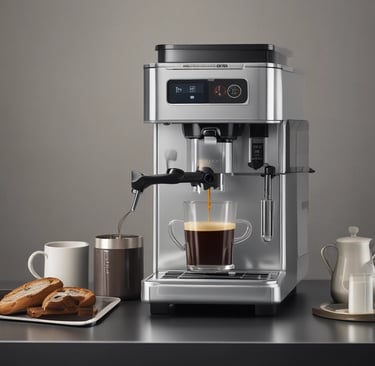Top 5 Brew Temperatures and Why They Matter
BLOG NEWS
10/26/20255 min read


Understanding Brew Temperature
Brew temperature is a critical factor in the preparation of coffee and tea, significantly impacting the extraction of flavors and aromas from the respective ingredients. In essence, brew temperature refers to the heat applied to water or other solvents used to steep coffee grounds or tea leaves. Different beverages require specific temperature settings to fully unleash their flavor profiles and aromatic qualities, making it an essential consideration for any brewing process.
The science of brew temperature lies in its influence on the extraction process. When hot water interacts with coffee grounds or tea leaves, it facilitates the dissolution of soluble compounds. These compounds include oils, acids, and various flavor molecules, which contribute to the overall taste and aroma of the finished brew. The heat aids in breaking down the cell walls of the tea leaves or coffee grounds, enabling the release of these soluble compounds into the liquid.
It is essential to recognize that varying the brew temperature results in different extraction levels. For instance, brewing coffee at a lower temperature might lead to a milder flavor with more acidic notes, while higher temperatures can intensify the bitterness and deepen the overall flavor profile. Similarly, tea varieties have specific brew temperature ranges that optimize flavor extraction: delicate white teas prefer cooler water, while robust black teas thrive at higher temperatures. Understanding these temperature relationships not only enhances the quality of the beverages but also elevates the overall sensory experience for the consumer.
Ultimately, mastering brew temperature is paramount for achieving the desired taste and quality in both coffee and tea. By appreciating the role of heat in extraction, one can better control the brewing process, leading to a more enjoyable and personalized experience.
The Optimal Brew Temperatures for Coffee
When it comes to brewing the perfect cup of coffee, the temperature of the water plays a crucial role. Different brewing methods require specific temperature ranges to extract the desired flavors and aromas from the coffee grounds. The ideal temperature range for most coffee brewing processes is generally between 195°F and 205°F (90°C to 96°C). Deviating from this optimal range can lead to undesirable results such as over-extraction or under-extraction, affecting the overall quality of the beverage.
For drip brewing, which is one of the most common methods, a water temperature of approximately 200°F (93°C) is recommended. This temperature allows for balanced extraction of the coffee's oils and soluble compounds, resulting in a rich and flavorful cup. If the water is too hot, it can cause over-extraction, leading to a bitter taste. Conversely, using water that is too cool may result in under-extraction, leaving the coffee weak and lacking in depth.
In the case of French press, the recommended brewing temperature also falls within the range of 195°F to 205°F (90°C to 96°C). When using this method, it is essential to steep the grounds for about four minutes. If the temperature is higher than optimal, the coffee can become over-extracted, presenting harsh notes. However, if the water is cooler, the extraction process slows, and the resulting coffee may taste sour and unbalanced.
Espresso brewing, which utilizes finely ground coffee, demands precise control over temperature as well. The optimal brewing temperature for espresso is approximately 202°F (94°C). This ensures that the coffee's rich flavors are extracted quickly, allowing for a concentrated and creamy espresso shot. Too high or too low temperatures can significantly impact the extraction process, leading to a less than satisfactory taste profile.
The Ideal Brew Temperatures for Tea
Tea is a globally cherished beverage, known for its rich variety and delightful flavors. Understanding the ideal brew temperatures for different types of tea is essential for unlocking their full potential. Each type of tea has unique characteristics that influence its optimal brewing temperature, resulting in a better flavor profile and enhanced health benefits.
Green tea, for instance, is best brewed at a lower temperature, typically between 160°F to 180°F (70°C to 80°C). This allows the delicate leaves to release their natural flavors without becoming bitter. Oversteeping or brewing at higher temperatures can result in a grassy or astringent taste that detracts from the enjoyable qualities of this tea. The health benefits of green tea, including its high antioxidant content, are also best preserved with lower brew temperatures.
In contrast, black tea thrives on boiling temperatures, generally ranging from 200°F to 212°F (93°C to 100°C). This higher heat extracts bold flavors, aromas, and beneficial compounds effectively, creating a robust and satisfying brew. The intense heat not only enhances its richness but also promotes the infusion of tannins, which impart a signature briskness to the tasting experience.
For white tea, a more gentle approach is again recommended. Brewing it at 160°F to 185°F (70°C to 85°C) preserves its subtle nuances, allowing for a delicate and sweet flavor profile to develop. The minimal processing of white tea necessitates this careful temperature control to highlight its natural sweetness without overwhelming bitterness.
Finally, herbal teas cover a wide spectrum, as they often contain various botanical elements. Generally, they are best steeped at near boiling temperatures around 200°F to 212°F (93°C to 100°C). The diverse leaves, roots, and flowers found in herbal blends require higher temperatures to fully extract their flavors and health benefits.
In conclusion, grasping the optimal brew temperatures for tea types significantly enhances the drinking experience. By paying attention to these temperature variations, enthusiasts can savor the unique flavor profiles, aromas, and health benefits that each tea offers, culminating in a more satisfying and enriching tea experience.
Why Brew Temperature Matters for Flavor Profiling
Brew temperature is a crucial factor in the extraction of flavors from coffee and tea, influencing not only the taste but also the overall experience of the beverage. Different temperatures can significantly enhance or mute certain flavor profiles, aroma characteristics, and mouthfeel, ultimately determining the quality and enjoyment of the drink. The ideal temperature for brewing coffee typically ranges from 195°F to 205°F (90°C to 96°C), while for tea, it varies depending on the type, with green tea often brewed at lower temperatures (around 160°F to 180°F or 71°C to 82°C) compared to black tea, which may require hotter water. This variation is essential in achieving the best flavor extraction.
At higher brewing temperatures, soluble compounds are extracted more rapidly, which can lead to a fuller-bodied flavor and pronounced aromas. However, excessive heat can also extract undesirable bitter notes and overly acidic flavors, detracting from the beverage's overall balance. Conversely, brewing at lower temperatures typically results in lighter, more delicate flavor profiles that may highlight floral and fruity notes, but can also leave the drink feeling somewhat thin or underwhelming.
Experimentation with brew temperatures is vital for enthusiasts seeking to refine their flavor profiles. A slight adjustment can lead to the discovery of new tastes and sensations that resonate with individual preferences. This personalized approach not only enhances the perception of the beverage but can significantly impact the drinker's satisfaction and appreciation of their craft. Understanding the science and implications of brew temperatures encourages exploration within the realm of coffee and tea, ultimately leading to a richer and more rewarding experience for the consumer.
